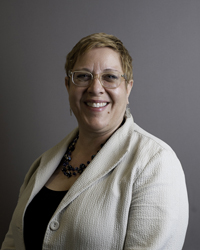
| Federal Home Loan Bank of Chicago | Community Investment eNewsletter | December 2013 |
Katrina Van Valkenburgh, Managing Director, CSH
In this Advisory Council Member Spotlight we introduce Katrina Van Valkenburgh, managing director for CSH (formerly known as the Corporation for Supportive Housing). CSH has a mission to advance housing solutions that deliver three powerful outcomes: 1) improve lives for the most vulnerable people, 2) maximize public resources, and 3) build strong, healthy communities. They accomplish this through training and education, policy reform, consulting, and lending.
Q: The permanent supportive housing (PSH) model – a combination of affordable permanent housing and voluntary supportive services designed to increase housing retention – was initially intended as a response to end chronic homelessness. Fast forward nearly 25 years and PSH is now used as an intervention for many at-risk populations. Why do you think the model has such broad applicability, and what kind of success rates have you seen across the country?
A: CSH was founded in 1991 and our early years focused exclusively on using supportive housing as a tool to end homelessness. Over the years, we’ve documented that when people who have been homeless move from the street or shelter into supportive housing their costs to our public systems decrease. For example, emergency room visits decrease by 57%, incarceration rates decrease by 50%, and emergency detox services decrease by 85%. At the same time, earned income increases by 50% and over 80% of tenants remain housed for a year or more.
We started looking at other populations that could benefit from supportive housing as a tool to solve some of the most complex and costly social problems our communities face. We’ve taken what we’ve learned from our work with the homeless system and are now working with other public systems like health care, public housing, addiction services, Veterans affairs, workforce services, criminal justice, and child welfare to adopt supportive housing to improve their systems’ responses to their most vulnerable clientele. What we are seeing is that the core elements of supportive housing work for populations that are not chronically homeless. People in state mental hospitals and jails, for example, often confront the same challenges as the street homeless population – mental illness, addiction, and chronic disease among others. Supportive housing provides the foundation to allow them to stabilize and live with greater independence and dignity.
Q: In 2010, the State of Illinois entered into a consent decree, settling the Williams v. Quinn class action lawsuit. The lawsuit alleged that Illinois was in violation of the Americans with Disabilities Act (ADA) and Section 504 of the Rehabilitation Act by “needlessly segregating” 4,500 Illinois residents with serious mental illness living in institutional settings. How has that impacted supportive housing providers and other stakeholders?
A: The Olmstead Supreme Court Decision in 1999 said that people with disabilities have the right to live in the most integrated settings possible. In the last few years, we have begun to see the settling of lawsuits related to Olmstead (there have been 105 lawsuits and 87 related cases across the country). The Illinois consent decrees focus on helping people with disabilities to live in the most integrated setting possible. At CSH, we have worked closely with the State to assist it in using supportive housing as a tool to move people from institutions into the community.
The Williams consent decree states that all 4,500 class members who were living in institutes for mental disease (IMDs) have the right to be screened to move into the community. The Ligas consent decree focuses on individuals with developmental disabilities already living in the community but waiting for services and those in intermediate care facilities of nine or more people. Ligas is an open class, meaning that it could grow, and already addresses 15,000 people. The Colbert consent decree focuses on people with physical and mental health disabilities living in nursing homes and contains approximately 15,000 people in Cook County. At the heart of these agreements is the idea of choice, that people in institutions with disabilities have the right to choose where they live and to be offered the services they need to live in the community. Supportive housing is an essential part of helping people successfully transition to community living after years of living in institutions.
Q: CSH is a Community Development Financial Institution (CDFI) offering a variety of loan products. Why are CDFIs so important to developers of affordable housing?
A: Like other CDFIs, CSH provides specialized financial assistance to a niche market that is not typically served by traditional financial institutions. We focus our lending services on the specific needs of developers creating supportive housing. What makes our lending unique is that we couple it with technical assistance to ensure that the housing being created is well-planned and well-positioned to obtain long-term financing from government and other sources. We are primarily a pre-development and acquisition lender, so we are able to go in very early – during the riskiest phase of the project – to help it move from concept to reality.
CSH offers products that allow us to support projects through the feasibility stage of the development process and favorably position it for additional financing. Our Supportive Housing Solutions Fund is a national loan fund that is designed to finance supportive housing in underserved communities. This fund brings together financing from national philanthropic and financial institutions along with funding from our 2012 Wells Fargo NEXT Award for Opportunity Finance. To date, CSH has committed over $350 million in projects across the country.


| Federal Home Loan Bank of Chicago | |
| 200 East Randolph Drive Chicago, IL 60601 www.fhlbc.com |
Copyright © 2013, Federal Home Loan Bank of Chicago. “Downpayment Plus,” “DPP,” “Downpayment Plus Advantage,” and “DPP Advantage” are registered trademarks of the Federal Home Loan Bank of Chicago. "Community First" is a trademark of the Federal Home Loan Bank of Chicago. |